Regional employment patterns in Scotland: statistics from the Annual Population Survey 2018
Summary publication of results from the Annual Population Survey 2018, presenting analysis on the labour market, education and training.
This document is part of a collection
Section 3: Characteristics of the workforce
3.1 Young people
The youth (16-24) employment rate in Scotland decreased by 2.1 percentage points over the year from 59.3 per cent in 2017 to 57.2 per cent in 2018, while the UK rate decreased by 0.3 percentage points from 54.0 per cent to 53.7 per cent over the same period.
The local authority areas with the highest youth (16-24) employment rates in Scotland in 2018 were Orkney Islands (89.9 per cent), Na h-Eileanan Siar (72.9 per cent) and Highland (70.4 per cent).
The areas with the lowest youth employment rates during this period were East Renfrewshire (37.3 per cent), Glasgow City (40.2 per cent) and East Ayrshire (47.1 per cent). It should be noted that youth employment rates in university cities are likely to be lower due to higher levels of economically inactive students.
Statistically significant changes over the year were seen in East Renfrewshire (down from 53.7 per cent to 37.3 per cent) and Midlothian (do wn from 80.3 per cent to 58.1 per cent). In total, 9 local authority areas saw increases in their youth employment rates over the year, with 22 seeing decreases.
Figure 4: Employment Rate 2018 16-24 year olds (per cent)
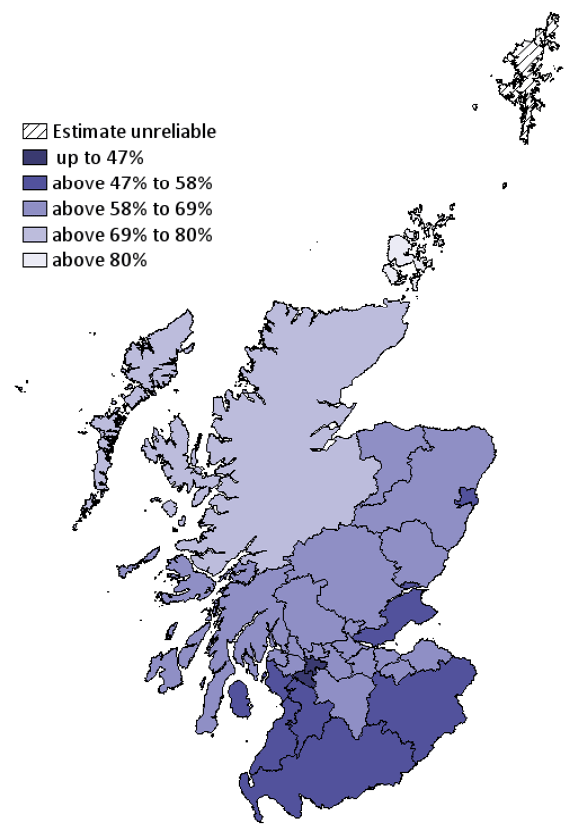
Note: data not available for Shetland Islands
3.3 Older workers
Figure 5: Employment Rate 2018 50 year olds and over (per cent)
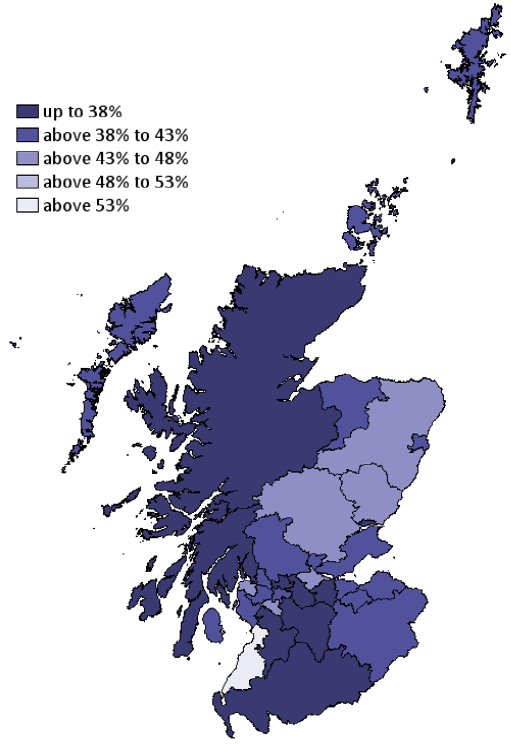
88,600 people aged 65 years and over were in employment in Scotland in 2018, almost twice as many as ten years ago.
The employment rate for those aged 65 years and over increased from 5.9 per cent in 2008 to 8.8 per cent in 2018*.
The employment level for those aged 50 to 64 years increased by 131,600 from 640,300 in 2008 to 771,900 in 2018. The employment rate increased from 65.2 per cent in 2008 to 69.7 per cent in 2018*. Women accounted for approximately two thirds (64.1 per cent) of the increase in employment for those aged 50-64.
The local authorities with the highest employment rate for those aged 50 years and over were: Shetland Islands (57.8 per cent), Orkney Islands (46.7 per cent) and Highland (45.8 per cent).
The most common reason for working past the age of 65 years was being ‘Not ready to stop working’ reported by 55.4 per cent.
Chart 16: Reasons for working for those aged 65 years and over in Employment, 2018
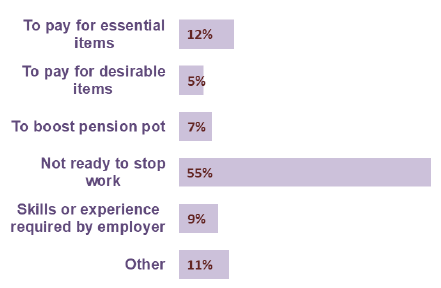
3.4 Disabled People
In 2018, the employment rate for those classed as disabled under the Equality Act 2010 was 45.6 per cent which is significantly lower than the employment rate for non-disabled people (81.1 per cent)*. In 2018, the employment rate gap was 35.5 percentage points.
The gap between the employment rate for disabled and non-disabled people has decreased by 0.4 percentage points over the year. The employment rate for disabled people increased slightly from 45.3 per cent in 2017 to 45.6 per cent in 2018, while the employment rate for non-disabled people decreased slightly from 81.2 to 81.1 per cent over the same period.
Figure 6: Employment rates (16-64) by Equality Act Disabled, 2018
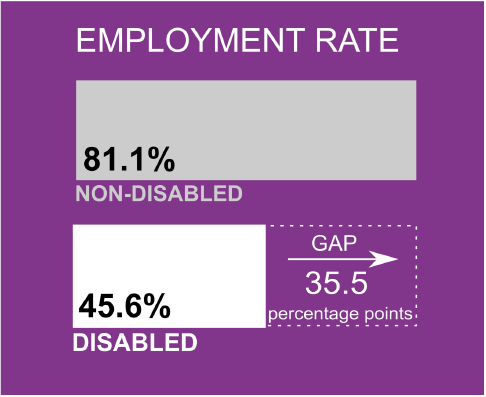
The gap between in the employment rate for disabled and non-disabled people was lower for women (31.1 percentage points) than men (40.0 percentage points).
Chart 17: Employment rate (16-64) for disabled and non-disabled by gender, 2018
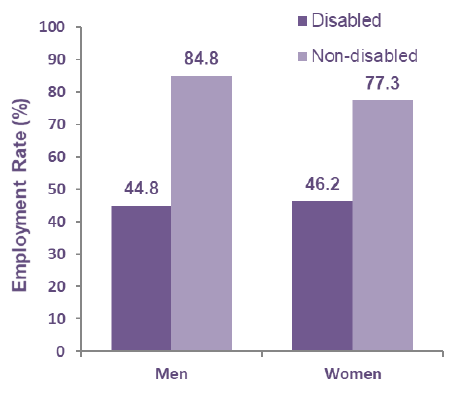
Data on disability
The disability employment gap is calculated as the non-disabled employment rate minus disabled employment rate.
Chart 18: Employment rate (16-64) by disability and age 2018, Scotland
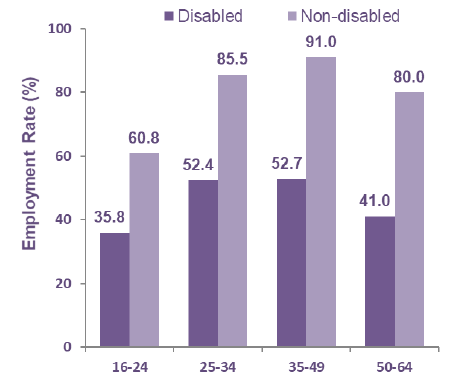
The employment rate gap between the employment rate for disabled and non-disabled people was lower for young people (25.0 percentage points) and increased with age with the gap being highest for those aged 50-64 years (39.1 percentage points).
There is regional variation in the employment rate for those who reported a disability. 22.5 per cent of all disabled people in employment work in Glasgow City (11.8 per cent) and Edinburgh (10.8 per cent).
Chart 19: Employment rate (16-64) for disabled people by local authority: 2014, 2018
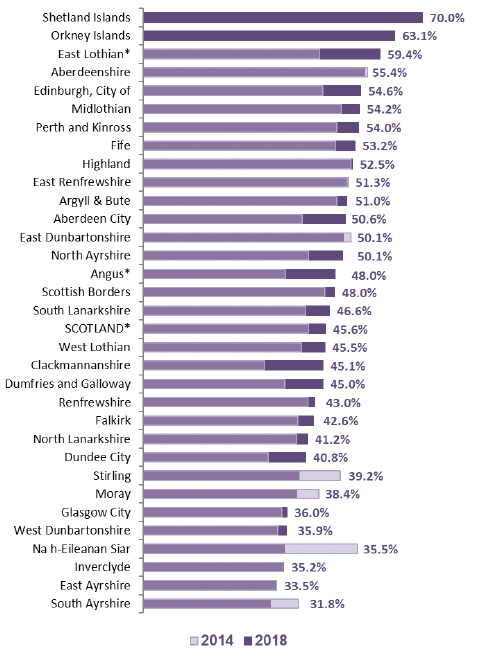
Note: Employment rate labels displayed for 2018
2014 rate not available for Shetland Islands and Orkney Island
3.5 Ethnicity
The employment rate for the minority ethnic population aged 16-64 was 55.4 per cent which is lower than the white population with an employment rate of 75.1 per cent giving a gap in employment rates between minority ethnic and white aged 16 to 64 years of 19.7 percentage points.
Over time, the white population has consistently had an employment rate which exceeds the minority ethnic population.
The minority ethnic employment gap was much higher for women than men in 2018; for women the minority ethnic employment gap was 26.8 percentage points and for men was 11.2 percentage points.
Chart 20: Employment rate (16-64) for minority ethnic and white population, 2004-2018, Scotland
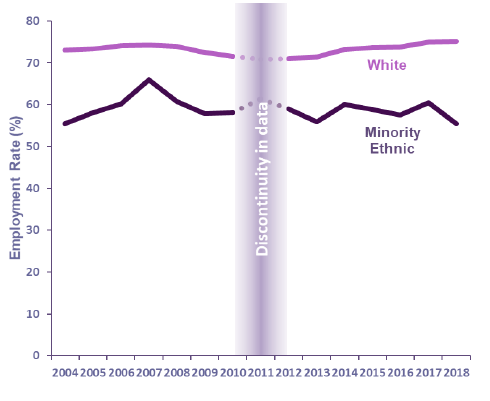
The employment rate for the minority ethnic population was highest in Mid Scotland and Fife (70.0 per cent) and Lanarkshire (67.4 per cent).
The gap in the employment rate for the minority ethnic population was largest for the 25-34 year old population (40.9 percentage points), followed by 16-24 year olds (28.2 percentage points), 35-49 year olds (11.8 percentage points) and 50-64 year olds (2.9 percentage points).
Chart 21: Employment rate (16-64) for minority ethnic and white people by gender, 2018
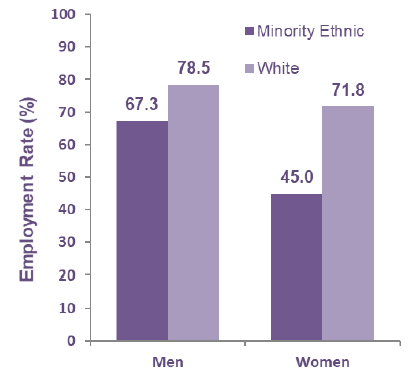
3.6 Scottish Index of Multiple Deprivation
The employment rate for the 20% most deprived areas in Scotland in 2018 was 62.5 per cent, the lowest employment rate across the SIMD quintiles.
Over time, the 20% most deprived areas of Scotland (Q1) have consistently had the lowest employment rates across Scotland.
Since 2008, the employment rate for the 20% most deprived areas of Scotland has increased from 59.6 per cent in 2008 to 62.5 per cent in 2018*. Over the same period, the employment rate for Q3 has increased from 75.6 per cent in 2008 to 77.8 per cent in 2018*. The employment rates for Q2, Q4 and Q5 (least deprived) have remained relatively constant between 2008 and 2018.
Chart 22: Employment rates (16-64) by SIMD quintile, 2004-2018, Scotland
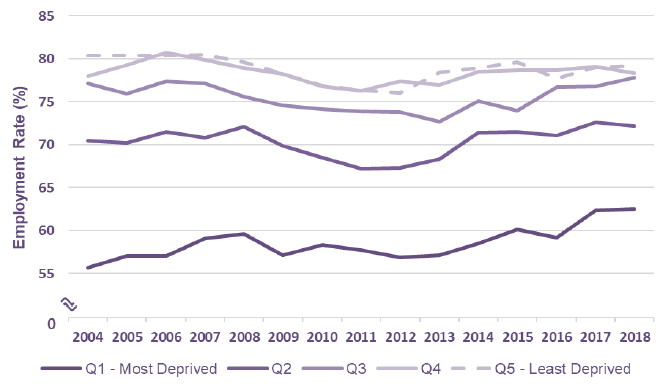
Table 1: Employment Rates (16-64) by SIMD Quintile
| 2008 | 2017 | 2018 | |
|---|---|---|---|
| Q1 - Most Deprived | 59.6 | 62.3 | 62.5 |
| Q2 | 72.1 | 72.6 | 72.2 |
| Q3 | 75.6 | 76.8 | 77.8 |
| Q4 | 78.9 | 79.1 | 78.3 |
| Q5 - Least Deprived | 79.6 | 79.0 | 79.2 |
* Statistically significant
Contact
If you have any enquiries relating to Labour Market Statistics then please contact us at:
Email: LMStats@gov.scot
Telephone: 0131 244 6773
Fax: 0300 244 1060
Post:
Labour Market Statistics
OCEAES: Economic Strategy and Policy
Scottish Government
5th Floor
5 Atlantic Quay
150 Broomielaw
Glasgow
G2 8LU
We welcome any comments on both the format and content of the website, including any problems you may encounter.
You may also contact the Statistician Group Enquiries for general information.
There is a problem
Thanks for your feedback